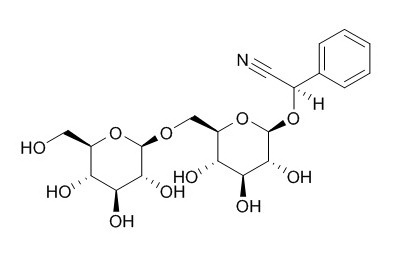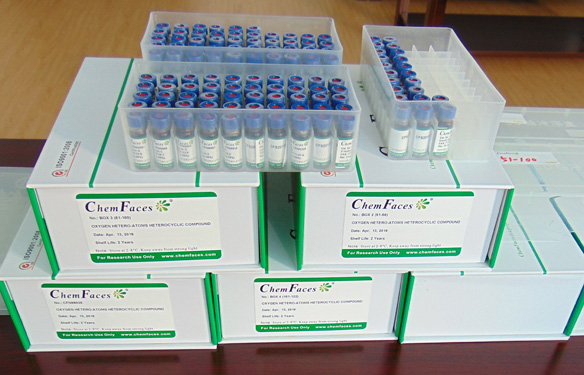Amygdalin
Amygdalin has antifibrotic, antitumor, anti-inflammatory and analgesic effects, amygdalin joint HSYA could inhibit the degeneration of the endplate chondrocytes derived from intervertebral discs of rats induced by IL-1beta and better than the single use of Amygdalin or HSYA. Amygdalin induces apoptotic cell death in human DU145 and LNCaP prostate cancer cells by caspase-3 activation through down-regulation of Bcl-2 and up-regulation of Bax.
Inquire / Order:
manager@chemfaces.com
Technical Inquiries:
service@chemfaces.com
Tel:
+86-27-84237783
Fax:
+86-27-84254680
Address:
1 Building, No. 83, CheCheng Rd., Wuhan Economic and Technological Development Zone, Wuhan, Hubei 430056, PRC
Providing storage is as stated on the product vial and the vial is kept tightly sealed, the product can be stored for up to
24 months(2-8C).
Wherever possible, you should prepare and use solutions on the same day. However, if you need to make up stock solutions in advance, we recommend that you store the solution as aliquots in tightly sealed vials at -20C. Generally, these will be useable for up to two weeks. Before use, and prior to opening the vial we recommend that you allow your product to equilibrate to room temperature for at least 1 hour.
Need more advice on solubility, usage and handling? Please email to: service@chemfaces.com
The packaging of the product may have turned upside down during transportation, resulting in the natural compounds adhering to the neck or cap of the vial. take the vial out of its packaging and gently shake to let the compounds fall to the bottom of the vial. for liquid products, centrifuge at 200-500 RPM to gather the liquid at the bottom of the vial. try to avoid loss or contamination during handling.
The Korea Journal of Herbology2020, 35(3):33-45.
Biomed Pharmacother.2020, 131:110673.
Antioxidants (Basel).2024, 13(3):340.
Life Sci.2021, 270:119074.
FEBS J.2022, 10.1111:febs.16676.
Phytomedicine.2022, 100:154058.
BMC Microbiol.2019, 19(1):78
J Nat Med.2022, 76(1):59-67.
Planta Med.2024, 2328-2750
Applied Biological Chemistry2022, 65(85).
Related and Featured Products
J Cancer Res Ther. 2014 Aug;10 Suppl 1:3-7.
Advanced research on anti-tumor effects of amygdalin.[Pubmed:
25207888]
Malignant tumors are the major disease that cause serious damage to human health, and have been listed as the premier diseases which seriously threatened human health by World Health Organization (WHO). In recent years the development of antitumor drugs has been gradually transformed from cytotoxic drugs to improving the selectivity of drugs, overcoming multidrug resistance, development of new targeted drugs and low toxicity with high specificity drugs. Amygdalin is a natural product that owns antitumor activity, less side effects, widely sourced and relatively low priced. All these features make the Amygdalin a promising antitumor drugs, if combined with conditional chemotherapy drugs, which can produce synergistic effect.
CONCLUSIONS:
In this paper, we summarized the pharmacological activity, toxicity and antitumor activity of Amygdalin, mainly focused on the advanced research of Amygdalin on its antitumor effects in recent years, providing new insights for the development of new anticancer drugs, new targets searching and natural antitumor mechanism investigations.
Neurol Res. 2007;29 Suppl 1:S59-64.
Amygdalin suppresses lipopolysaccharide-induced expressions of cyclooxygenase-2 and inducible nitric oxide synthase in mouse BV2 microglial cells.[Pubmed:
17359643 ]
Amygdalin (D-mandelonitrile-beta-D-gentiobioside) is a cynogenic compound found in sweet and bitter almonds, Persicae semen and Armeniacae semen. Amygdalin has been used for the treatment of cancers and for the relief of the pain. We made an aqueous extraction of Amygdalin from Armeniacae semen. In this study, the effect of Amygdalin on the lipopolysaccharide (LPS)-induced inflammation was investigated.
METHODS AND RESULTS:
The effects of Amygdalin extracted from Armeniacae semen on the LPS-stimulated mRNA expressions of cyclooxygenase (COX)-1, COX-2 and inducible nitric oxide synthase (iNOS) in the mouse BV2 microglial cells were investigated using 3-(4,5-dimethylthiazol-2-yl)-2,5-diphenyltetrazolium bromide (MTT) assay, reverse transcription-polymerase chain reaction (RT-PCR). The effects of Amygdalin on the prostaglandins E(2) synthesis and the nitric oxide production were also studied by performing prostaglandins E(2) immunoassay and by detecting nitric oxide.
The present results showed that Amygdalin suppressed the prostaglandin E(2) synthesis and the nitric oxide production by inhibiting the LPS-stimulated mRNA expressions of COX-2 and iNOS in the mouse BV2 cells.
CONCLUSIONS:
These results show that Amygdalin exerts anti-inflammatory and analgesic effects and it dose so probably by suppressing the mRNA expressions of COX-2 and iNOS.
Mol Med Rep. 2013 May;7(5):1453-7.
Amygdalin inhibits renal fibrosis in chronic kidney disease.[Pubmed:
23525378]
Renal interstitial fibrosis is a common outcome of chronic renal diseases. Amygdalin is one of a number of nitrilosides, the natural cyanide‑containing substances abundant in the seeds of plants of the prunasin family that are used to treat cancer and relieve pain. However, whether Amygdalin inhibits the progression of renal fibrosis or not remains unknown.
The present study aimed to assess the therapeutic potential of Amygdalin by investigating its effect and potential mechanism on the activation of renal interstitial fibroblast cells and renal fibrosis in rat unilateral ureteral obstruction (UUO).
METHODS AND RESULTS:
Treatment of the cultured renal interstitial fibroblasts with Amygdalin inhibited their proliferation and the production of transforming growth factor (TGF)‑β1. In the rat model of obstructive nephropathy, following ureteral obstruction, the administration of Amygdalin immediately eliminated the extracellular matrix accumulation and alleviated the renal injury on the 21st day. Collectively, Amygdalin attenuated kidney fibroblast (KFB) activation and rat renal interstitial fibrosis.
CONCLUSIONS:
These results indicate that Amygdalin is a potent antifibrotic agent that may have therapeutic potential for patients with fibrotic kidney diseases.
Yao Xue Xue Bao. 2014 Aug;49(8):1136-42.
The synergistic effect of amygdalin and HSYA on the IL-1beta induced endplate chondrocytes of rat intervertebral discs.[Pubmed:
25322555]
The effect of Amygdalin joint hydroxysafflor yellow A (HSYA) on the endplate chondrocytes derived from intervertebral discs of rats induced by IL-1beta and the possible mechanism were studied and explored.
METHODS AND RESULTS:
Chondrocytes were obtained from endplate of one-month SD rat intervertebral discs and cultured primary endplate chondrocytes. After identification, they were divided into normal group, induced group, Amygdalin group, HSYA group and combined group. CCK-8 kit was adopted to detect the proliferation of the endplate chondrocytes. FCM was measured to detect the apoptosis. Real-time PCR method was adopted to observe the mRNA expression of Aggrecan, Col 2 alpha1, Col 10 alpha1, MMP-13 and the inflammatory cytokines IL-1beta. The protein expression of Col II, Col X was tested through immunofluorescence. Compared with the normal group, the proliferation of the endplate chondrocytes decreased while the apoptosis increased (P < 0.05). With down regulation of the mRNA expressions of Aggrecan, Col 2 alpha1 and up regulation of the mRNA expressions of Col 10 alpha1, MMP-13, IL-1beta (P < 0.05), the protein expression of Col II decreased while the protein expression of Col X increased. Compared with the induced group, Amygdalin group, HSYA group, the combined group could inhibit the apoptosis and promote the proliferation (P < 0.05). They could increase the mRNA expressions of Aggrecan and Col 2 alpha1 while decrease the mRNA expressions of Col 10 alpha1, MMP-13 and IL-1beta (P < 0.05). They could also enhance the protein expression of Col II while reduce the protein expression of Col X.
The effect of the combined group was significantly better than that of Amygdalin and HSYA.
CONCLUSIONS:
Amygdalin joint HSYA could inhibit the degeneration of the endplate chondrocytes derived from intervertebral discs of rats induced by IL-1beta and better than the single use of Amygdalin or HSYA.
Immunopharmacol Immunotoxicol. 2013 Feb;35(1):43-51.
Amygdalin induces apoptosis in human cervical cancer cell line HeLa cells.[Pubmed:
23137229]
Amygdalin, a naturally occurring substance, has been suggested to be efficacious as an anticancer substance.
The effect of Amygdalin on cervical cancer cells has never been studied.
METHODS AND RESULTS:
In this study, we found that the viability of human cervical cancer HeLa cell line was significantly inhibited by Amygdalin. 4,6-Diamino-2-phenyl indole (DAPI) staining showed that Amygdalin-treated HeLa cells developed typical apoptotic changes. The development of apoptosis in the Amygdalin-treated HeLa cells were confirmed by double staining of Amygdalin-treated HeLa cells with annexin V-FITC and propidium iodide (PI) along with increase in caspase-3 activity in these cells. Further studies indicated that antiapoptotic protein Bcl-2 was downregulated whereas proapoptotic Bax protein was upregulated in the Amygdalin-treated HeLa cells implying involvement of the intrinsic pathway of apoptosis. In vivo, Amygdalin administration inhibited the growth of HeLa cell xenografts through a mechanism of apoptosis.
CONCLUSIONS:
The results in the present study suggest that Amygdalin may offer a new therapeutic option for patients with cervical cancer.



